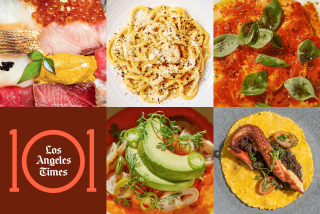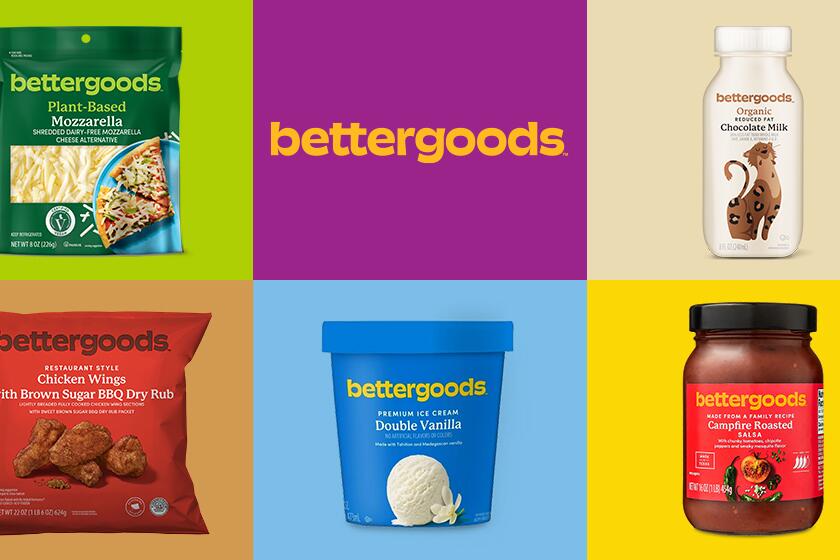Thinner wallet, better diet
Nutrition experts predict that most Americans may be slightly more concerned with the economy than, say, their antioxidant consumption in the months ahead.
If that’s the case, the quest for a healthful and cost-conscious diet suggests Americans will be eating more meals cooked at home, upping their produce and whole-grain intake and eschewing sodium. “It’s the back-to-basics bailout diet,” says Shelley McGuire, professor of nutrition at Washington State University in Pullman.
--
Benefits of grains
More and more people are realizing the health benefits of whole grains, says Joan Salge Blake, clinical assistant professor of nutrition at Boston University, who predicts that the year ahead could be a good one for popcorn (which is, in fact, a whole grain). Studies have shown that a diet rich in whole grains -- barley, oats, brown rice and newly trendy quinoa are other examples -- can help reduce the risk of heart disease, diabetes and stroke.
The high-fiber content of whole grains, which confers many of their health benefits, also means that “they fill you up but don’t fill you out,” Blake adds.
Whole grains also lend themselves to hearty, home-cooked meals, Blake says.
When people eat at home, they’re often likely to eat more healthfully, she adds, citing a number of recent food industry innovations -- pre-cooked rice in a bag, clean and chopped fresh vegetables and fruits, including the microwave-in-bag varieties -- that are facilitating the consumption of quick but nutritious meals at home.
Of course, eating in has an additional benefit, says McGuire, who is also a spokeswoman for the American Society for Nutrition. “You can eat for cheap if you do it at home,” she says.
--
Eating out vs. in
But many Americans will still eat out, recession or no, and with good reason: “Our culinary skills have vastly declined over several generations,” says Greg Drescher, executive director of strategic initiatives for the Culinary Institute of America in Greystone, Calif. Fortunately, from a nutrition standpoint, he says, restaurant chefs are showing an increased interest in adding innovative items featuring whole grains and a variety of produce to their menus.
The trend has arisen in response to a growing consumer interest in so-called “stealth health,” Drescher says. “People want to eat healthy but don’t want to be reminded about it,” he explains.
Americans have a much more sophisticated approach to healthful eating than they did five or 10 years ago, Drescher adds. More and more, they’re realizing that there are no “magic bullet” foods (i.e. oats) or food types (i.e. low-fat versions of foods) and are instead embracing a more holistic approach to healthful eating, one that emphasizes variety and whole, less-processed foods.
“An interest in a broad spectrum of flavors is spreading throughout the country,” Drescher says.
McGuire agrees, and predicts that -- combined with economic constraints -- such an interest could alter the choices consumers make in their pursuit of a healthful diet. “People are going to give up really expensive functional foods and vitamin drinks,” she says. “We have an incredible agricultural system that produces inexpensive food,” she adds, “but we have been so frivolous with our food dollar.”
--
Cutting back on salt
Americans have also been frivolous, arguably, with a seemingly innocuous condiment: salt. “Salt is by far the cheapest thing around. It’s an easy fix” for any food item, says Michael Jacobson, executive director of the Center for Science in the Public Interest, a Washington, D.C.-based nutrition advocacy group.
Studies have shown that high sodium intake can raise blood pressure, increasing the risk of heart disease and stroke. As a result, salt ranks high on the list of things Americans are trying to avoid, says Barbara Katz, president of HealthFocus International, a market research firm in St. Petersburg, Fla.
This coming year, consumers may get some help from Uncle Sam. Several government agencies are investigating ways to reduce sodium in the American diet -- particularly in restaurant and packaged foods -- as a way to prevent heart disease, Jacobson says. “The British government has made sodium reduction a top priority,” Jacobson says. “Food companies are worried that the U.S. government may follow suit.”
--
Safer foods
The number of reduced-sodium food items (such as Campbell’s sea-salt seasoned soup) is already growing, but Jacobson predicts that consumers may soon see more manufacturers not just reducing salt, but replacing it with blends of herbs and spices and so-called “bitter blockers,” chemicals that block unpleasant tastes (thereby reducing the need to mask them with salt).
Bitter blockers, however, may not be the best bet for food manufacturers in 2009. Chemical additives and preservatives also rank high on the list of items consumers are avoiding in their quest for better health, Katz says. “There’s an interest in purity,” she says. “People want to know what’s in their food.” That interest, she says, is also driving people to shop local and cook at home more -- as are the recent chemical-contamination scares related to food products produced in China.
An American population that cooks more, consumes less salt and eats more whole grains and produce may turn out to be a reality in the year ahead -- or just wishful thinking.
But if one thing seems certain, it’s this, says Linda Smithson, co-president of Food Watch, an Edina, Minn.-based research firm that tracks food trends: Until the economy shows sure signs of recovery, most Americans, health-conscious or not, won’t be eating caviar and truffles.
--
More to Read
Eat your way across L.A.
Get our weekly Tasting Notes newsletter for reviews, news and more.
You may occasionally receive promotional content from the Los Angeles Times.






